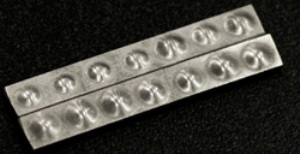Jul 9 2013
Researchers at North Carolina State University have developed a new metallic bubble wrap that is lighter, stronger and more flexible than sheet metal and more heat- and chemical-resistant than plastic or other polymer-based bubble wraps. Potential applications include automobile body panels, the wing edges of airplanes, suitcases, helmets and cases for computers and other electronic devices.
 The metallic bubble wrap was developed to offer protection in areas that are only a few millimeters thick. Image credit: Afsaneh Rabiei.
The metallic bubble wrap was developed to offer protection in areas that are only a few millimeters thick. Image credit: Afsaneh Rabiei.
“This material does exactly what sheet metal and other bubble wraps do, but better,” said Dr. Afsaneh Rabiei, professor of mechanical and aerospace engineering and the lead researcher on the project. “And it won’t cost businesses and consumers very much because producing it requires just a few steps.”
Rabiei developed the metallic bubble wrap to offer protection in areas that are only a few millimeters thick. To be effective, such materials must be thin enough to fit inside tightly spaced product linings, flexible enough to withstand twisting and bending, and strong enough to protect the contents inside.
To create the bubble wrap, Rabiei started with a thin sheet of aluminum and used a studded roller to dot the material with small indentations. Then she deposited a foaming agent — such as calcium carbonate or titanium hydrate — into the indentations. When heated, such agents decompose and create bubbles.
Rabiei covered the aluminum with another sheet, sandwiching the foaming agent in its indentation troughs. She ran a heavy roller over the two sheets to bond them together. In the final step, she placed the combined sheet into a furnace, where the heat broke down the foaming agent and created air bubbles in the material. The process is akin to baking soda causing batter to rise when baking a cake.
The researchers applied a variety of mechanical tests to the metallic bubble wrap to evaluate its properties and compare it with the original bulk sheet metal. The bubble wrap, which weighs about 20 to 30 percent less than the bulk material, offered a 30 to 50 percent increase in bending strength. The tensile strength — essentially the material’s breaking point — was nearly identical to the non-bubbled metal.
“The way we created this material could be used for any sheet metal, not just aluminum,” Rabiei said. “We plan to further develop our metallic bubble wrap and hope it eventually offers better protection for products and the public.”
Rabiei announced the creation of the bubble wrap June 24 at the 8th International Conference on Porous Metals and Metallic Foams in Raleigh, N.C. A paper on the invention is forthcoming in the conference’s proceedings.
Rabiei’s keynote presentation, including the metallic bubble wrap and its method of processing, was picked as one of the technical highlights of the conference by the audience. A poster presentation on the topic received the first place poster award.